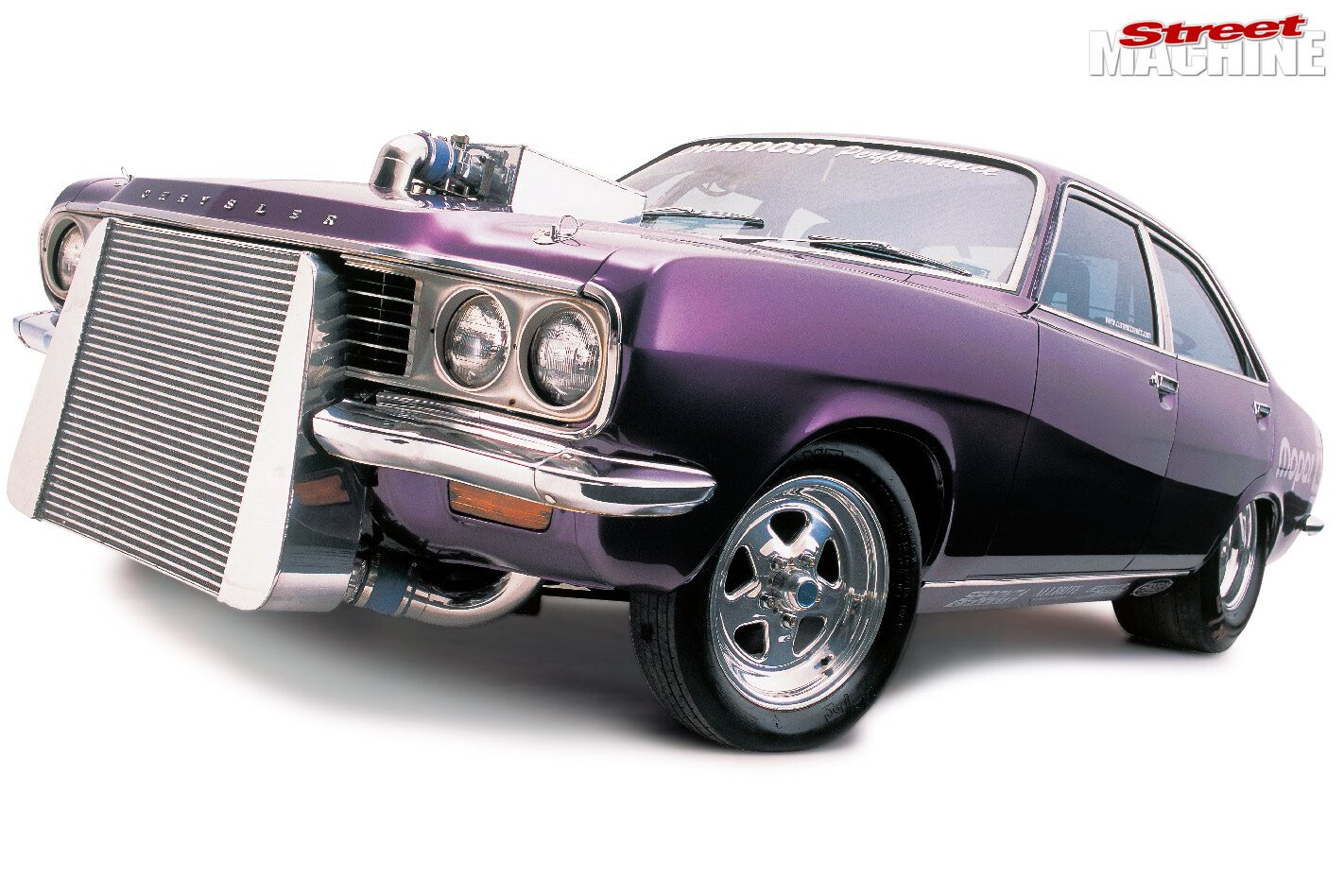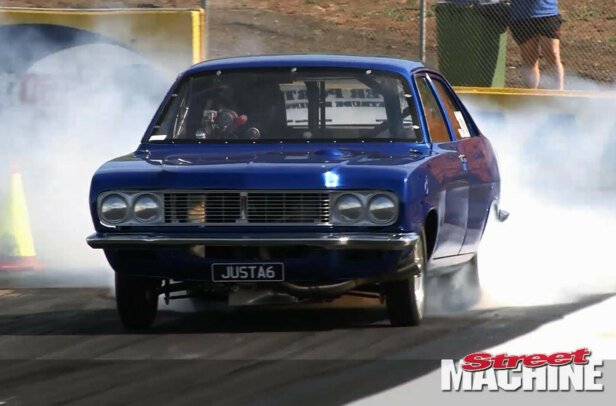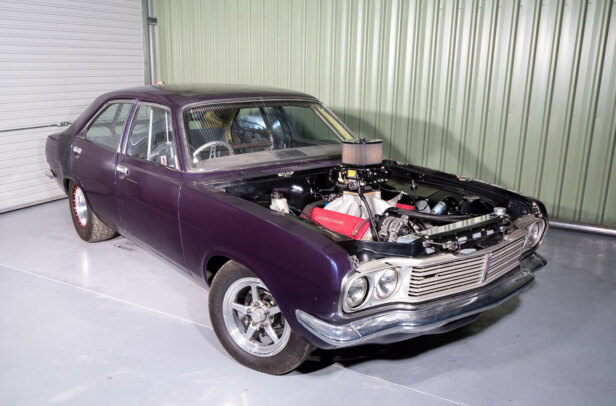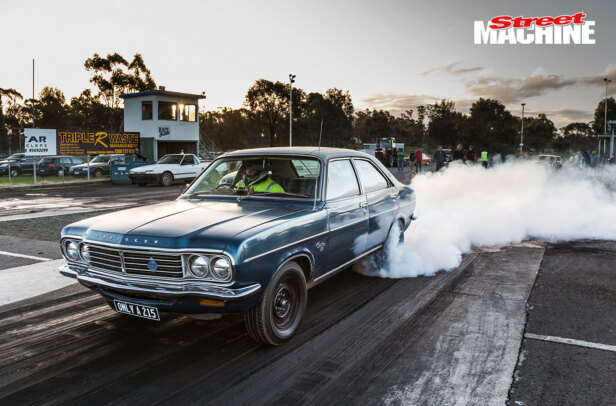KILLING an engine in your car is no fun at all. It’s messy, it puts your wheels off the road and it’s not too healthy on the back pocket either.
This article was first published in the June 2004 issue of Street Machine
Just ask Col Palmer — he’s been racing Chryslers down the quarter mile for years now and after a long affair with nitro, he’s seen the light.
So what was the turning point?
Not too long ago he was punting an old VJ Dodge ute up and down the streets with more than the occasional blast down Kwinana’s quarter mile. It wasn’t a bad old beast that Dodge. It weighed a heap and consumed parts faster than a recycling yard, but it could also trip the lights in 10.32 at a healthy 127mph — no wonder, with 340 cubes of finest Mopar and an extra 175hp-worth of nitro.
It wasn’t all fun and games though, and after it killed the engine for the third time Col thought there just had to be a better way to sprint quarters. Firstly there was the weight. That old Dodge weighed too much and it was causing havoc with the rest of the drivetrain, especially the 727 Torqueflite auto. Col had a few let go — the last one through the finish line — and the damage from the explosion convinced him of the value of a ballistic blanket. It’s damn hard to race with no legs.
So he needed something lighter, but still Chrysler. No point being silly about these things — it’s not like he was about to go and buy a Holden or anything like that.
A search through Chrysler’s inventory turned up some interesting vehicles but the two-doors were dropped as they’re just too common at the drags. Col liked the idea of making a four-door family grocery-getter into a quick beast and his gaze fell upon the obscure Chrysler Centura.
At 1200kg it was light enough, and the fact that there was plenty of room for the big hemi six meant there was more than enough room for a small block Mopar V8. There was also the bonus that the obscurity of the Chrysler Centura made it a cheap buy with immaculate versions going for a few grand.
A poo-brown Centura for 1000 bucks from a deceased estate turned out to be the one. It was rust-free and straight, and the crook colour didn’t matter since it was going to be painted anyway. Granny had looked after it — with only 92,000km on the clock the Centura was one sweet machine.
Sweet or not, it didn’t take Col long to strip out the non-essentials, cut the rear out of the old girl and weld in a full mild-steel cage and a sizeable pair of tubs for the wide, sticky rubber that was to come.
With the running gear ripped out Col had the guys at All Bright Paint and Panel de-badge and strip the low mileage machine. He also had them weld up the fuel filler flap on the driver’s side rear quarter before squirting it with a colour Col calls Mystery Purple. The original buckets were dumped in favour of some Sparco race seats, re-trimmed in a distinctly non-factory grey along with the rest of the interior. Autometer gauges keep tabs on just about everything from water temperature and oil pressure to the alignment of the planets.
With the Centura already looking one hundred per cent better than any ever left Tonsley Park, a pair of 15×12 Cragar Dragstars were fitted under the rear, with 13.5in-wide Mickey Thompsons. Up front a set of 3.5in-wide Cragar’s took a set of M/T front runners. A white bumble-bee stripe across the arse makes this Centura a sight to behold.
What about motivation though? Col had plenty of experience with Hemi sixes but he knew the small block was more reliable. He briefly considered a 340 but a high failure rate with nitro knocked that idea down. How about one of those 360 Chryslers though? You rarely see a broken one and it’s practically a bolt-in proposition with the light Centura shell — a match made in Mopar heaven.
So he gave up the evil blue bottle and turned to the turbo instead.
He set about creating the mother of all Mopar small blocks, a relatively low-revving piece that would torque its way down the blacktop.
If 360 cubes are good then 408 are better, and it was pretty easy to achieve with a cast 4in Mopar stroker crank. Custom Ross pistons, fitted to Eagle rods, squeeze the intake charge against a pair of ported Edelbrock aluminium heads, shooting 480 horses through the rear tyres.
That 408 doesn’t do it all on its own though — a largish Garrett TV70 turbo jams the air into an XF Falcon throttle body on the front of an aluminium plenum which sits atop a Weiand tunnel ram.
Col fitted eight Indy Blue injectors into the manifold to squirt methanol straight down the ports. Look closely at the pics and you might just spot an intercooler up front. It may not be totally necessary at the current low boost level (11lbs) but it will be needed when the boost gets wound up to 20-25psi. The extra boost will drop the turbo into its efficiency range — at the moment it’s not even raising a sweat. With a MoTeC M4 controlling the shooting match he’s gonna be making a whole bunch more power shortly but tuning hasn’t been without dramas.
On the dyno, a couple of stuck injectors saw raw methanol hitting the inside of a hot exhaust, spewing blast furnace-like flames against the back wall of
the dyno room. If that wasn’t hairy enough, the engine kept running even after the key was shut off, sucking the tank dry in 30 seconds and melting all the electrical connections on the wall. Col’s partner Claire had a few strange misgivings about the switch to methanol but is otherwise totally supportive, something he’s very thankful for.
But all the power in the world isn’t worth spit if you don’t have the drivetrain to support it. Col’s got a heavily modified, reverse-pattern 727 Torqueflite and 5000rpm Dominator, with a ballistic blanket situated between the trans and his naughty bits. Further back, a four-inch tailshaft feeds power to the 3.5 geared nine-inch, the meat in the sandwich between 480hp and 13.5 inches of sticky rubber. How long will it last? Who knows!
Col would like to see nines with the 11lb boost he’s using, but he’s looking for a mid-eight down the road, when he ups the boost level.
Just imagine if Granny could see her beloved old Centura now!
Engine bay in detail:
A. Custom box-style plenum chamber sits on a Weiand tunnel ram.
B. Eight Indy Blue injectors deliver methanol straight into the ports.
C. Oversized air-to-air intercooler for minimal inlet temperatures and maximum intimidation.
D. Turbine beanie keeps searing heat out of the engine bay
E. The turbo is a Garrett V70 but at current boost levels this baby isn’t even raising a sweat. With 25psi wound in, the turbo will be working at maximum
efficiency for monster grunt!
F. XF Falcon throttle body.
G. Blow off valve.
H. Remote oil filter.
WHAT’S A CENTURA?
IN THE early 70s, manufacturers thought oil was going to run out in the near future and created smaller cars like the Torana and Cortina, but Chrysler only had American battle cruisers. It needed a mid-sized sedan and found the Chrysler 180 in France.
It was a medium-sized sedan with an 87kW, 2.0-litre motor that could squeeze out a respectable-at-the-time 17-second quarter but Chrysler Australia knew it couldn’t front up with just a four-potter. So it stretched the nose of the 180 until a 4-litre Hemi six fitted, inventing the Centura and power oversteer in one go.
Where the four-cylinder version had won praise in the European motoring press for deft handling, the six caused concern. “Over powered” and “nose heavy” they quipped, and the Centura’s race was over.
The first model, the KB, was available with a 2-litre four-cylinder, or a choice of 3.5 or 4.0-litre Hemi six. You could further select between three-speed auto or three and four-speed floor-shift manual options.
The later KC’s used Valiant steering columns to eliminate the four-stalk columns of the KB and came with only the 4.0-litre straight six. By ’78 the writing was on the wall for Chrysler Australia and the Chrysler Centura was one of the victims.
But it did leave a legend. Swapping out the econo-donks for a 4.3-litre (265ci) engine became the way to embarrass SLR-5000 owners. The 4.3-litre engine put the Centura into a whole new performance category while maintaining factory road manners and appearance.
Rumour insists some of the last KCs came factory-fitted with 4.3-litre engine — we’ll believe it when we see the E33 code on the option plate.
COL PALMER
1976 CHRYSLER KB CENTURA
Colour: Mystery Purple
Engine
Type: Chrysler 360
Heads: Edelbrock ported alloy, with oversized 2.05in intake valves
Crank: Cast Mopar Performance
Rods: Eagle 3D H-beam
Capacity: 408ci
Intake manifold: Weiand tunnel ram with custom box plenum
Throttle body: XF Falcon
ECU: MoTeC M4
Forced Induction: Garrett TV70 (rated 1200hp) and the mother of all intercoolers




Comments